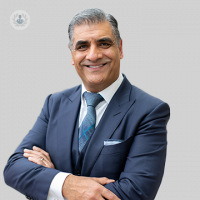How dangerous is bicuspid aortic valve disease?
Written by:Finding out that you or a loved one has a rare heart disease is always worrying, but understanding the condition better can be a step closer to reassurance. Mr Inderpaul Birdi, an expert heart surgeon from London describes bicuspid aortic valve disease and how it’s treated.

What is bicuspid aortic valve disease?
The aortic valve is found at the beginning of a large artery called the aorta – the main artery from the heart that releases oxygenated blood to the body. The aortic valve is a one-way valve that prevents blood from travelling back towards the heart when it closes.
In around 99% of people, the valve is made up of three leaflets (tricuspid), however in a small number of patients the valve is bicuspid, meaning that it is only made up of two leaflets. For many years, the valve can work perfectly before problems start to show.
What are the risks with bicuspid aortic valve disease?
Usually, bicuspid aortic valve disease is present at birth but isn’t diagnosed until later in life. Over time, a bicuspid aortic valve degenerates and calcifies causing a disorder known as aortic stenosis. Those who have aortic stenosis, usually found in middle age, often have bicuspid aortic valve disease too.
To prevent serious problems such as stroke, or even premature death, the aortic valve needs to be replaced. For some people, the valve begins to regurgitate which lets the blood flow back towards the heart. This can, unfortunately, lead to heart failure.
What is the association between the bicuspid aortic valve and aortic aneurysm?
Many patients with bicuspid aortic valve disease present with associated weakness in the wall of the aorta pipe. This can cause the aorta to swell which is known as an aortic aneurysm.
An aortic aneurysm is rather dangerous. If it’s left untreated, it can get bigger and cause the aorta to tear or rupture, leading to internal bleeding and/or a stroke.
Men over the age of 65 are more at risk of this condition and the treatment is to surgically repair or replace the aortic valve and the enlarged aorta.
Can the aortic valve be repaired rather than replaced?
Yes, in some circumstances the aortic valve can be preserved rather than replaced. In aortic regurgitation, certain features of the valve may respond better to being repaired than replaced.
In situations where the aorta is also enlarged, we are more likely to preserve the aortic valve using a procedure known as aortic valve-sparing aortic root replacement (David procedure).
What’s the benefit of preserving the bicuspid valve?
Preserving the aortic valve offers better long term durability over tissue valves as well as avoiding the drawbacks of blood thinners which are required with mechanical valves.
Also, the flow of blood around the body is far better when the valve is repaired, which provides better long term benefits in terms of recovery of the heart to normal function.
Can bicuspid aortic valve disease be treated using keyhole heart surgery?
Yes, if certain criteria are met, then the majority of patients can undergo minimal access surgery.
This type of surgery has many benefits including less pain and bleeding, quicker recovery, fewer chances of infection and complications and overall better cosmetic results.
Mr Inderpaul Birdi is a leading keyhole heart surgeon based in London. Visit his profile here where you can read his areas of expertise, book an e-consultation with him or arrange to visit him in person.


